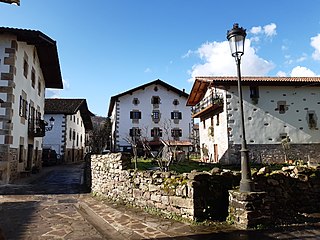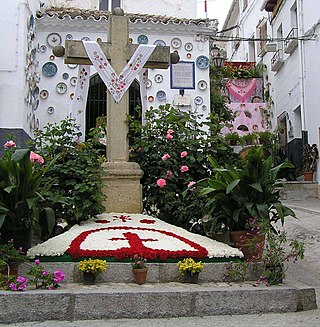Berbinzana (Basque: Berbintzana) is a town and municipality located in the province and autonomous community of Navarre, in northern Spain.
Berbinzana (Basque: Berbintzana) is a town and municipality located in the province and autonomous community of Navarre, in northern Spain.

Berbinzana is a small village located in Navarre province, in Northern Spain. (Navarre is best known for the town of Pamplona and its "Sanfermines"). Berbinzana is on the banks of the Arga River and surrounded by fertile fields. Agriculture is the primary economic activity. Berbinzana also has a wide variety of plants and animals. Berbinzana has a deeply rooted culture and is faithful to its traditions, where the festivities are celebrated with the traditional red handkerchief.
Berbinzana has a fairly typical Mediterranean climate, with warm summers and cold winters. The Arga river tempers this some and provides many wild animals to the area.
There are several groups that promote cultural activities. These include "San Isidro", with more than six hundred members, the young society of "La Unión", and the football club CD Injerto.
A good time to enjoy visiting Berbinzana is during one of its numerous events. Here are some of the main holidays:
The principal activities are the festivals, the running of the bulls, dances, fireworks and other spectacles.
42°32′N1°50′W / 42.533°N 1.833°W

The Aragón is a river in northern Spain, one of the left-hand tributaries of the river Ebro. It rises at Astún in the central Pyrenees Mountains, passes southwest through Jaca and Sangüesa (Navarre), and joins the Ebro at Milagro (Navarre), near Tudela. The name Aragón is related to the birth area of the former kingdom, which corresponds to the modern autonomous community of Aragón in Spain.

Macabebe, officially the Municipality of Macabebe, is a 1st class municipality in the province of Pampanga, Philippines. According to the 2020 census, it has a population of 78,151 people.

Barañain is a town and municipality located in the province and autonomous community of Navarre, northern Spain.

Ituren is a town and municipality located in the province and autonomous community of Navarre, northern Spain. Ituren sits on a westernmost outlying area of the Pyrenees, 56.5 km north of Pamplona. It lies on the flood plain of the River Ezkurra, a tributary of the River Bidasoa, in the shadow of the Mendaur mountain which is characterised by the tiny white-washed chapel of La Trinidad, on its summit.

Miranda de Arga is a town and municipality located in the province and autonomous community of Navarre, northern Spain.

Orcoyen is a town and municipality located in the province and autonomous community of Navarre, northern Spain, being part of Pamplona's metropolitan area. Its population currently stands at 3,637 inhabitants. Its population density is of 0.69 inhabitants/km2. This area is home to one of Spain's most industrious regions, which is Pamplona's metropolitan area; this has triggered a transition from an agricultural background, giving way to the automotive industry.
Peralta is a town and municipality located in the province and autonomous community of Navarre, northern Spain. It is located 59.5 km from Pamplona, and is on the River Arga, a tributary of the Aragon River which itself flows into the Ebro. The population in 2020 was 5951 (INE) inhabitants. Peralta is one of twenty-seven municipalities that make up the Merindad de Olite in the southern part of Navarre.

Puente la Reina is a town and municipality located in the autonomous community of Navarre, in northern Spain.

San Adrián is a town and municipality located in the province and autonomous community of Navarre, northern Spain. There was an ancient monastery dedicated to San Adrián y la Virgen de la Palma there, after which the village is named.

Villava is a town and municipality located in the province and autonomous community of Navarre, northern Spain. The population is about 10,000, and the town is located 4 km away from Pamplona, the capital of Navarre.

Totana is a municipality in the Region of Murcia in Spain. It has a population of 32008. The local economy is largely dependent on agriculture and related industries. It has a railway station providing a service on the Cercanías Murcia/Alicante commuter line, providing connections to Alicante and Murcia.

Isidore the Labourer, also known as Isidore the Farmer, was a Spanish farmworker known for his piety toward the poor and animals. He is the Catholic patron saint of farmers, and of Madrid, El Gobernador, Jalisco, La Ceiba, Honduras, and of Tocoa, Honduras. His feast day is celebrated on 15 May.
Castellar de Santiago is a municipality in the province of Ciudad Real, Castile-La Mancha, Spain. It has a population of 1,819 inhabitants as of 2022, with a density of 20.59 people per Km². Due to its proximity, it is part of the Valdepeñas judicial district.

Albuñol is a city located in the province of Granada, Spain. According to the 2007 census, the city has a population of 6,270 inhabitants.

Navarra is a Spanish Denominación de Origen Protegida (DOP) for wines from the southern half of the autonomous community of Navarre. The vineyards are on the lower slopes of the Pyrenees as they descend towards the basin of the river Ebro.

Fuente Álamo de Murcia is a town and municipality in the Region of Murcia, southern Spain. It is situated 22 km northwest of Cartagena and 35 km south west of Murcia. The town lies in the basin of the Mar Menor surrounded by the mountains of Algarrobo, Los Gómez, Los Victorias and the Carrascoy.

Torre-Pacheco is a municipality in the autonomous community of Murcia in southeastern Spain. It covers an area of 189.4 km² and its population in 2019 was 35,676. The only high ground in the municipality is Cabezo Gordo hill, the location of the protected Sima de las Palomas archeological site. The town has one secondary education institution, the I.E.S. Gerardo Molina.

The Fiesta de las Cruces or Cruz de Mayo is a holiday celebrated on 3 May in many parts of Spain and Hispanic America.

Ausejo is town and municipality in the province and autonomous community of La Rioja, Spain. The municipality covers an area of 56.58 square kilometres (21.85 sq mi) and as of 2011 had a population of 1122 people.